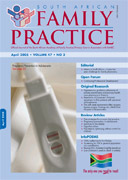Die sesweke-ondersoek ná koronêre vatchirurgie: bevindinge by Bloemfontein Medi-Clinic Hospitaal.
Abstract
The six-week examination after coronary bypass surgery. Findings at a Medi-Clinic Hospital in Bloemfontein. Background: Surgery provides symtomatic relief and improves the prognosis in patients with coronary artery disease. The general practitioner manages the postoperative patient. The aim of the study was to establish which symptoms and signs are present at the time of the six-week follow-up after coronary artery bypass graft surgery. Methods: A descriptive database search with a retrospective direction of enquiry was undertaken to establish the symptoms and signs experienced by patients six weeks after coronary artery bypass surgery (CABG). The patients were operated on by one surgeon in one hospital. The prevalence of readmissions, chest pain, angina, blood pressure, NYHA class, lung auscultation, wounds and medications were noted. Results: Records were available for 181 patients. However, only 158 patients were seen in the surgeon’s rooms six weeks after surgery. Patients were also consulted before and after the six weeks, but usually in hospital. One patient died before her appointment and two patients did not return for follow-up. Fifteen (8.5%; 95% CI 4.9% to 13.7%) patients were readmitted to a hospital for a variety of reasons, Severe chest pain was present in 3.4% (95% CI 1.3% to 7.2%) patients. One patient had a myocardial infarction with patent grafts at cardiac catheterisation. Another two patients were investigated for possible angina, but it could not be proved. A total of 82.2% (95% CI 76.5% to 87.9%) of the patients were in NYHA I, whereas 3.5% (95% CI 1.3% to 7.4%) were class III, of whom two thirds were in class III before the operation. Hypertension was noticed in 70.1% of the patients (95% CI 62.9% to 77.2%). During auscultation of the lungs, abnormalities were picked up in 4.9% of the patients, while the sternum was not properly healed in 3.4% (95% VI 1.3% tot 7.2%). All the patients were on aspirin, but only 57% took an ACE inhibitor, 37% took a statin and 29% a beta-blocker. Conclusions:This study provides a picture of what to expect six weeks after a CABG. (SA Fam Pract 2005;47(3): 61-64)
Published
2005-04-01
Section
Original Research
By submitting manuscripts to SAFP, authors of original articles are assigning copyright to the South African Academy of Family Physicians. Copyright of review articles are assigned to the Publisher, Medpharm Publications (Pty) Ltd, unless otherwise specified. Authors may use their own work after publication without written permission, provided they acknowledge the original source. Individuals and academic institutions may freely copy and distribute articles published in SAFP for educational and research purposes without obtaining permission.

